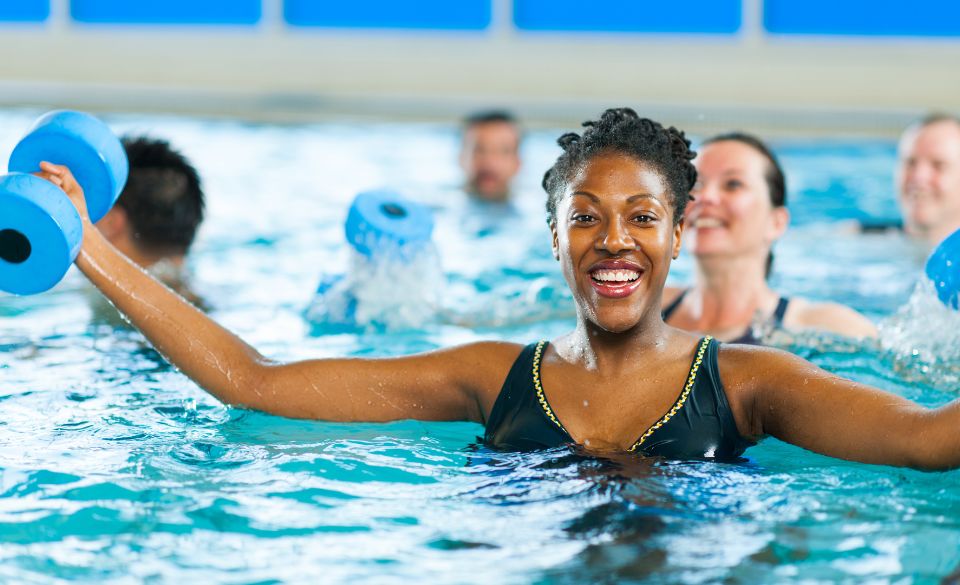
Aqua Jogging For Runners – The Benefits, Technique & More.
Page Contents
Aqua jogging, also known as water running, is a low-impact form of exercise that has been gaining popularity in recent years. It involves running or jogging in a pool while wearing a buoyancy belt to keep the body afloat. This workout has numerous benefits for runners, including reducing the risk of injury and improving cardiovascular endurance.
The purpose of this blog post is to explore the benefits of aqua jogging for runners, as well as provide tips on how to incorporate it into their training routine. Whether you are a seasoned runner or just starting out, aqua jogging can be an effective cross-training tool to help you reach your fitness goals. Let’s dive in and explore the benefits of aqua jogging for runners in more detail.
Benefits of Aqua Jogging For Runners
Aqua jogging provides many benefits for runners. Here are some of the most notable advantages:
Low-Impact Workout: Running on hard surfaces like concrete and asphalt can be tough on joints and can lead to injuries such as shin splints and stress fractures. Aqua jogging provides a low-impact alternative to running on land. The buoyancy of the water reduces the impact on the joints, making it a great option for runners who need to give their joints a break or who are recovering from an injury.
Reduced Risk of Injury: As mentioned, aqua jogging is a low-impact workout, making it a great option for runners who are looking to reduce the risk of injury. Additionally, the resistance provided by the water helps to strengthen muscles, which can also reduce the risk of injury.
Improved Cardiovascular Endurance: Aqua jogging provides a challenging cardiovascular workout that can improve endurance. The resistance of the water requires more effort to move through than air, which means that your heart and lungs have to work harder to supply oxygen to your muscles. This can lead to improved cardiovascular endurance, which can translate to better performance on land.
Increased Muscle Strength and Tone: Aqua jogging provides resistance that challenges the muscles in a different way than running on land. The water provides constant resistance in all directions, which helps to tone and strengthen muscles throughout the body.
Enhanced Recovery from Running Injuries: Aqua jogging can be a great option for runners who are recovering from an injury. The low-impact nature of the workout means that you can continue to exercise while allowing your injury to heal. Additionally, the resistance provided by the water can help to improve muscle strength and flexibility, which can aid in the recovery process.
Burn More Calories than Traditional Jogging: Aqua jogging can burn more calories than traditional jogging because of the resistance provided by the water. According to the American Council on Exercise, a 150-pound person can burn approximately 272 calories in 30 minutes of aqua jogging, compared to 238 calories in 30 minutes of jogging on land.
In conclusion, aqua jogging provides numerous benefits for runners, including a low-impact workout, reduced risk of injury, improved cardiovascular endurance, increased muscle strength and tone, enhanced recovery from running injuries, and the ability to burn more calories than traditional jogging. If you’re looking to switch up your cross-training routine or recover from an injury, aqua jogging may be worth exploring.
Equipment needed For Aqua Jogging
To get started with aqua jogging, you will need some equipment. Here’s a breakdown of the essential gear you’ll need:
Aqua Jogging Belt: An aqua jogging belt is a flotation device that wraps around your waist and helps to keep your body upright in the water. It’s essential for maintaining proper form and technique during your aqua jogging workout. You can find aqua jogging belts at most sporting goods stores or online retailers.
Pool: You’ll need access to a pool that’s deep enough to allow for proper form and technique during your aqua jogging workout. Ideally, the pool should be at least 4 feet deep.
Swimwear: You’ll need to wear appropriate swimwear for your aqua jogging workout. Look for a swimsuit that’s comfortable and allows for a full range of motion.
Water Shoes: Water shoes are optional but can be helpful if the pool floor is slippery or if you have sensitive feet. They provide extra traction and support and can make your aqua jogging workout more comfortable.
Waterproof Music Player: If you like to listen to music during your workouts, consider investing in a waterproof music player. Many brands make waterproof MP3 players that you can use while aqua jogging.
That’s it! With just a few pieces of equipment, you can start enjoying the benefits of aqua jogging in no time. As you become more experienced with the workout, you may want to add other pieces of equipment, such as hand paddles or resistance bands, to increase the challenge and variety of your workouts.
How to position the body for proper form and technique
Proper form and technique are essential to getting the most out of your aqua jogging workout and reducing the risk of injury. Here are the key tips for positioning your body correctly during your aqua jogging workout:
1. Strap on your aqua jogging belt: Before getting into the water, put on your aqua jogging belt and adjust it so that it fits snugly around your waist. The belt should keep your upper body upright and allow you to maintain proper posture during your workout.
2. Stand tall: Once you’re in the water, stand tall with your shoulders back and your head up. This will help you maintain proper alignment throughout your workout.
3. Engage your core: Engage your core muscles by pulling your belly button in towards your spine. This will help to stabilize your body and improve your balance in the water.
4. Move your arms naturally: Allow your arms to move naturally as you jog in the water. Your arms should swing back and forth in a relaxed motion, just as they would if you were jogging on land.
5. Keep your knees lifted: To maintain proper form, keep your knees lifted as you jog in the water. Your knees should come up to about hip level with each stride.
6. Use a consistent stride: To get the most out of your workout, use a consistent stride as you jog in the water. This means taking the same number of strides per minute as you would when running on land.
By following these tips for proper form and technique, you can get the most out of your aqua jogging workout and reduce the risk of injury. Remember to start at a comfortable pace and gradually increase the intensity and duration of your workout as you become more experienced.
Breathing Techniques For Aqua Jogging
Breathing is an essential aspect of any exercise, including aqua jogging. Here are some tips to help you master proper breathing techniques while aqua jogging:
1. Breathe rhythmically: Just like when you’re running on land, breathing rhythmically is key to maintaining your endurance and avoiding fatigue. Try to establish a comfortable breathing pattern that fits your pace and stride.
2. Breathe in through your nose: Breathing in through your nose helps to warm and humidify the air before it reaches your lungs. This can help to reduce irritation and improve lung function.
3. Exhale through your mouth: Exhaling through your mouth releases carbon dioxide from your body and helps to regulate your breathing.
4. Keep your face in the water: To breathe effectively while aqua jogging, keep your face in the water and exhale underwater. When you need to take a breath, turn your head to the side and inhale through your nose or mouth.
5. Practice controlled breathing: As with any exercise, it’s important to practice controlled breathing to avoid hyperventilation and maintain proper oxygen levels in your body.
By incorporating these breathing techniques into your aqua jogging routine, you can improve your endurance, reduce the risk of fatigue and injury, and get the most out of your workout. Remember to start at a comfortable pace and gradually increase the intensity and duration of your workout as you become more experienced.
How to Incorporate Aqua Jogging into Your Running Routine
Incorporating aqua jogging into your running routine can provide a low-impact, high-intensity workout that can help you to build endurance, increase cardiovascular fitness, and recover from injury. Here are some tips for how to incorporate aqua jogging into your running routine:
Start slow: If you’re new to aqua jogging, start with shorter sessions and lower intensity workouts. Gradually increase the duration and intensity of your aqua jogging workouts as your fitness level improves.
Use it for cross-training: Incorporate aqua jogging into your cross-training routine. Instead of running on land, spend a session or two each week aqua jogging in the pool. This can help to give your body a break from the impact of running on hard surfaces and reduce the risk of injury.
Add it to your recovery routine: Aqua jogging can also be a great way to recover from injury. If you’re experiencing pain or discomfort when running, switch to aqua jogging for a few sessions to help your body recover.
Mix up your workouts: To keep your workouts interesting and challenging, try mixing up your aqua jogging routine. Use different equipment, try different speeds and intervals, and incorporate other exercises into your routine.
Make it a social activity: Aqua jogging can be a great way to socialize with other runners. Consider joining an aqua jogging class or organizing a group workout with other runners.
Incorporating aqua jogging into your running routine can be a fun and effective way to improve your fitness and reduce the risk of injury. Remember to start slow, gradually increase the intensity and duration of your workouts, and mix things up to keep your workouts interesting and challenging.
Conclusion
In conclusion, aqua jogging is an excellent cross-training tool for runners. It offers numerous benefits, including low-impact exercise, muscle building, cardiovascular endurance, and injury recovery. With the right technique, equipment, and breathing techniques, aqua jogging can be a fun and effective workout that can help you reach your fitness goals.
Remember to start slow and gradually increase the intensity of your workouts as your fitness level improves. Don’t be afraid to mix things up and try different workouts to keep your aqua jogging routine interesting and challenging.
Overall, if you’re looking for a low-impact exercise that can help you build endurance, reduce the risk of injury, and improve your running performance, aqua jogging is definitely worth a try. Give it a chance, and you might be surprised at the positive impact it can have on your running routine.


